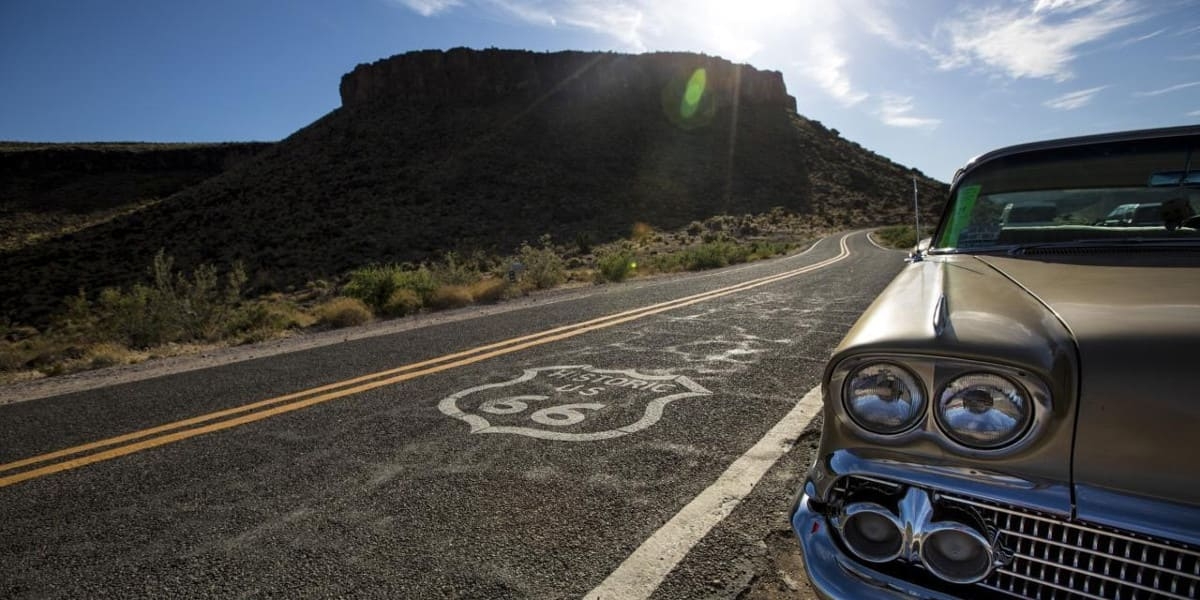Why Do Americans Drive On the Right?
 |
| Why Do Americans Drive On the Right? |
| Table of Content |
Driving in the US is hugely different from driving in the UK, or anywhere in Europe for that matter, which is why we have gathered all the tips and advice you need to successfully navigate the States highways.
There are some elements of US driving that take some getting used to though, including driving on the right. You’ll also need to get used to undertaking on the freeways, and going wheel-to-wheel with the massive pick-up trucks so loved by the locals, as well as knowing and understanding rules of the road that – for example – allow you to ‘turn on red’ at traffic lights.
So whether you’re planning a route across the US, or just want to say you’ve spent a day in a convertible muscle car on your US holiday, before you start hunting down those US rental car companies, scroll down to read our tips and advice on all the paperwork, rules of the road and knowledge you need to have fun and stay safe – and legal – on your US road trip.
Road Types in the USA
The US has a number of road types. These, in our experience, can be broadly categorized as follows:
Interstate Roads
As the name suggests, an Interstate is a road that runs across states. These can be compared to Motorways in the UK or the autobahns in Germany. They are usually at least two lanes, and they have on and off-ramps rather than stop signs or traffic lights.
Interstates keep the same number regardless of state – Interstate 40 for example, runs through eight states and is called Interstate 40 in all of them.
Maximum speeds on the Interstate vary by state, from 60 mph through to 80 mph. Speed limits are clearly posted and should be obeyed.
State Roads
A State Road is specific to a state. State Road 54 in one State is going to be a different road to a State road in another state.
State roads vary from dual-carriageway styles to single-lane highways, and as they pass through towns, cities, and villages, the speed limit can vary from as low as 20 mph up to 75 mph. As always, check local state regulations and obey posted speed limits.
County Roads
A county road is any road that is maintained by the local county authority, rather than the state or federal system. County roads are usually smaller, slower roads, and they have a “C” or “CR” designation, followed by a number.
They do vary in size and quality, from freeway-sized right through to unpaved roads, depending on the area, traffic, and local county budget. Again, as they vary hugely in quality and size, speed limits on County Roads also vary tremendously.
Driving Rules and Regulations in the US
- Seatbelts are required for all passengers in all vehicles.
- Children are required to be in safety seats or booster seats. Babies in baby seats are not allowed to be put in the front seat facing forward because of risks from airbags.
- Some interstates or freeways have high-occupancy lanes (HOV) marked by signs and a white diamond shape on the road. You are allowed to drive in these between certain hours only if you have 2 or more people in your vehicle.
- In many states, it is required by law to move over if a vehicle is stopped on the right-hand shoulder with hazard lights flashing. This also pertains to service vehicles like tow trucks or police and emergency vehicles.
- If you are stopped by the police, pull over safely to the side of the road, turn the car off, roll down your window, and do not exit the vehicle. Also, be sure to have your driver’s license and car insurance or protection plan on hand to show.
Why Do Americans Drive on the Right?
 |
| Photo: usvisaupdate |
To know Americans drive on the right, we have to go back to long before the automobile was even on the scene. In Medieval times, horseback riders kept to the left side of the road in order to keep their swords on their right sides, closer to any potential approaching enemies. This also allowed riders to mount and dismount on the left side of the road instead of in the middle.
Left-hand traffic became law in Britain in 1773, and the empire exported its driving norm throughout their colonies, which is why many former British territories such as Australia, New Zealand, South Africa and India still drive on the left.
Meanwhile, in 18th-century France the rich normally rode on the left, while peasants kept to the right side of the road. After the French Revolution, former aristocrats felt safer keeping a low profile and fell in line with the rest of the citizenry on the right. Driving on the right became law in France in 1794, and the custom spread throughout much of continental Europe.
Around the same time in the United States, goods and food were commonly transported on large wagons pulled by pairs or teams of horses. As many cargo wagons didn’t have a seat, the driver would ride the rear left horse in order to keep their right hand free to carry the whip. Riding on the right ensured that the whip never inadvertently hit a passing rider.
In addition, following the American Revolution, the fledgling country wanted to throw off any remaining ties with England. By 1813 driving on the right was law in three states.
The design of Henry Ford’s Model T, with the driver’s seat on the left side of the car, sealed the deal. A handful of countries—Canada, Italy, and Spain—switched to right-side driving in the 1920s as cars became more popular. More recently, Sweden just switched to right-side driving in 1967.
Which documents need to drive in the US?
You’ll be glad to hear that you can rent a car in the US with your UK license. The US has an agreement with the UK whereby a full and valid UK driver’s license permits vehicle rental in the States, you will have to have held your license for over a year.
In most cases, you have to be above 21 but some companies will insist that you’re 25 before handing you the keys to a rental car. A passport and visa are obvious requirements to enter the country and will be needed to rent a car as well.
How To Get A United States Driving License?
If you’re going to stay longer or want to extend your visa, then you should consider getting a US state-issued driving license. As a foreigner, you can apply for and receive one for yourself.
Since you’ll not be having an SSN, you’ll be asked to submit two ID proofs with your name, DOB, and picture on it. Along with that, proof of residence. After that, pay the required fees and take the driving test. If you pass, you’ll receive a temporary license valid for 30 to 90 days and your permanent license will be mailed to you within that time frame.
Driving in the USA: Top Tips
Watch out for undertaking
The undertaking is perhaps the biggest culture shock for UK motorists on US roads. The undertaking is not illegal and is exercised on most motorways. US drivers aren’t particularly fond of indicating direction change, either, which will make you watch your mirrors even more closely.
Right turns at red lights
You’re also allowed to turn right when a traffic light is red, provided that there is no oncoming traffic.
Take your turn at the crossroads
If you come to a four-way intersection without lights, the car that arrived first has priority and then the next. This will take some getting used to, so when approaching intersections slow down and keep an eye out on who’s arrived at the top mark and when.
State Laws
One of the first things to be aware of in the USA is that there are generally two types of law – federal laws, which apply to the whole country, and state laws, which vary depending on the state you are in.
The majority of traffic laws are set at a state level, which means that they vary depending on the state you are in – things like speed limits, age limits, and drink or drug driving laws.
Some things are country wide of course. All traffic for example drives on the right (with the exception of the US Virgin Islands), you need a driving license to drive, and there are speed limits on all roads, although these vary by state.
Age Limits for Driving in the USA
The age at which you are legally allowed to drive alone on a full driving license in the US varies by state, but falls between 16 and 18 years of age. Here’s a full list of legal driving ages by state.
As a visitor, you will generally find that most cars hires companies will require you to be over 21 to rent a car, and there is usually a surcharge for renting a car if you are under 25. See more below on this subject in the car rental section.
Can foreigners drive in the US?
 |
| Photo: aman |
The United States driving laws state that you’re required to have a valid driving license in possession to be able to drive in the US. This can be either issued by a US State or a foreign country. So, yes, you can drive with a foreign license in the US.
But that doesn’t mean to say there aren’t any form of limitations. Being a foreigner in the US, you need to be aware of them and follow them diligently.
Your License Should Be Issued in English
The first requirement is that the driving license should be issued in English. The name, digits, symbols have to be in English and easily readable. If not, then you’re required to have an IDP or International Driving Permit issued by your native country. Some officials and travel agents will even recommend an IDP over your country-issued driving license. But as long as it is valid, is in English, and you aren’t going to drive for more than 3 months (we’ll explain why in the below section), there shouldn’t be any problem.
Alternatively, you can use translation services to translate your driving license from your local language to English. Some states like Texas accept licenses in Spanish, but it is not recommended. You can get in touch with the US Consulate in your country to get the license translated.
No Medical Conditions that Affect Driving Ability
Besides that, you shouldn’t have any apparent medical conditions which would otherwise forbid you from driving. When applying for a driving license in the US, applicants have to undergo a medical examination consisting of vision tests and seizure disorder tests among others. Ideally, you shouldn’t have any of these.
How Long Can You Drive With A Foreign License?
The US allows all visitors to drive up to 3 months with a foreign driving license. This is from the date they make an entry into the US as per official records. Post this, your foreign license won’t work. To continue driving, you must obtain an IDP. But you also must be aware of the fact that the United States doesn’t issue IDP to short-term visitors. It can only be obtained from your native country.
But getting the IDP is different for short-term visitors and residents. Therefore, you need to follow the right method based on which category you fall under.
Speed LimitsThere are no countrywide speed limits in the US, making it tricky for drivers planning to travel to more than one state. The best advice is to look out for signs and pay attention to how fast others are driving. Just be aware that many areas are monitored by radar (often posted with signs) and if you drive too fast you might be surprised with a speeding ticket in the mail. Within cities, speed limits are generally 25-30 mph unless otherwise noted. The maximum speed limits for interstates and freeways range from 65-80 mph. The speed limit in school zones is 10-25 mph (16-40 kph) when the yellow warning lights are flashing when children are present or during school pick-up and drop-off hours. By law traffic in both directions must stop when a school bus flashes its red lights. These rules are strictly enforced. |
 Top 10 States With The Highest Gas Prices In America Top 10 States With The Highest Gas Prices In America Take a look at these states with the highest gas prices in the U.S, considering if you are looking to travel here on your summer ... |
 Top 10 States With The Cheapest Gas Prices In America Top 10 States With The Cheapest Gas Prices In America With the gas prices soaring high across the United States, you can still fill your pump with a fair, rather cheap, amount of money in ... |
 Top 10 Most Best and Popular Bed Styles In America Today Top 10 Most Best and Popular Bed Styles In America Today Let's find out the most popular bed models used by American families today. |























